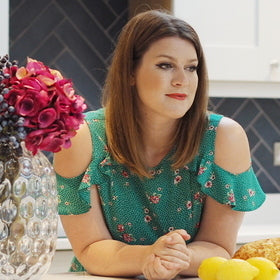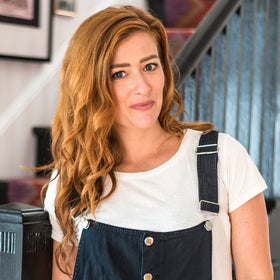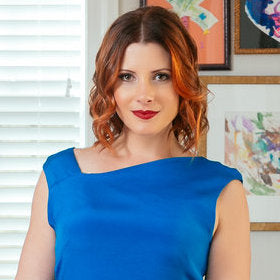Moving in with a partner is a huge step in any relationship. Your everyday life and schedules collide, and you'll find you need to get used to sharing a lot more with your partner - including your home. If you both are moving into a new apartment or house, it can feel like a fresh beginning. But if one partner moves in the home of the other, then it may feel like an invasion of personal space.
One area where challenges appear is when you have different tastes in decorating. It's a bit of a cliche, but for example, when it comes to colour schemes, some women are quite girly and gravitate towards pinks and purples, while men tend towards more austere blacks, whites and grey tones.
We've also found women tend to accumulate more things, even if rarely used, while guys tend to prefer a more minimalist look - not to be confused with tidiness of course! That said, we have also seen plenty of cases where the dynamics are the other way around.
In these situations, the ideal solution is to hire a professional interior designer to find common ground, and decorate your home in such a way that your respective tastes actually compliment each other. Designers will often incorporate low cost, high impact items such as wall mural wallpaper, that can be easily updated as your tastes evolve over time.
But if hiring an interior designer is not in the budget, or you just want to take things into your own hands, then we have the perfect solution for you.
We reached out to 34 interior designers and asked them a simple question:
A couple is moving in together for the first time and they have different tastes - what advice would give them on how to decorate their home in a way that captures both their styles and personalities?
We received some very interesting tips that you can read below.
Francis Toumbakaris - Francis Interiors

I think a couple should always start with what has the most sentimental value and they should come to an agreement in terms of — not necessarily style — but what is a necessity and what isn’t. As a designer, I am a firm believer that items people are in love with can always find a place in their home. But, it has to make sense.
There is a major determining factor of what design styles will work for any space. Any home has a unique style in terms of lighting, layout, floor plan and elements within the rooms. That includes existing kitchen cabinets, bathroom design, and flooring as well as architectural details such as molding details and hardware.
These are the things a couple should consider first and foremost with regard to taste. For instance, if the home or apartment gives a traditional vibe and feels very romantic, a black faux-leather, Jersey basement sofa may not be the best fit.
When both are strong headed in wanting to keep their things, I suggest the one-for-one — for instance, if you want me to give up this painting, you have to give up that chair.
Based on how many bedrooms the apartment has, it’s possible a couple may decide "this is your room" and "this is my room." Or, maybe one partner will take ownership of a bedroom and the other will take ownership of another bedroom or office den.
The reason why this couple is in a relationship is that there are certain elements that bond them, such as mutual interests and activities. Try and figure out, extraneous of different styles, whether there is a common thread in the color palette. If there is consistency in the palette, then furniture and items in different styles are fine.
At the end of the day, moving in together signifies a new beginning in the couple’s life. It may not be a bad idea to leave things of the past behind for a fresh start.
Eddy Homes

Give Each Space a Purpose – Especially when you’re moving into a new place together, you are working with a blank canvas. You may want to have one room act as more of an aesthetic piece while your partner may think it is meant for heavy use. Getting on the same page there will be vital when it comes to understanding how you hope to furnish it.
Give and Take - You have to be willing to give a little and take a little. At the end of the day, it is unlikely that you’ll be able to decorate the space with everything you want and the same is true of your partner. Decide together what things you can agree can stay and what must go. Try and do this as equally as possible, as forcing your partner to let go of the majority of their stuff while you get to keep the bulk of your things is not a fair compromise.
Having a Couple Style - Many people think that when it comes to compromising on décor, it’s all about finding a way to incorporate both peoples’ styles. This is only partly true as it is important to forgo in a sense your individual styles and find your style as a couple. This may incorporate elements of both, but it should have its own flair that both your influence and your partners’ can be found in.
Find the Colors That Work For You - Often times it is not so much the furniture in the room that shapes the space, but rather the color. Color is a great framing tool and can even overshadow some of the style of the room. Because of its prominence, even if one partner’s influence is slightly more apparent in the space, finding a common ground on a color and its hue can still help everyone feel like they have won.
Leigh Spicher - Ashton Woods

Now, this might be the best question redesign I’ve been asked in a while! We experience this challenge in the Studio almost every day! There is good news though! If you are living together some fundamental design principles can also apply to life and serve as some tips for designing a home that reflects the personality of all the people who live there.
Let’s look:
1. Balance: A-hem. Things in a relationship cannot always be one-sided. One person cannot carry the weight or burden of any one thing. So, let’s apply that to a lesson in design. If one person loves contemporary design and the other loves traditional design, choose finishes or décor with clean lines, but layer in texture.
One of my favorite examples today is a slab-style (contemporary) kitchen cabinet, that has the traditional texture of oak or hickory. Maybe you can have it both ways?
2. Harmony: A designer I trust, recently described harmony as the whole orchestra and if one of the sections (let’s say brass) is missing, it just doesn’t sound right. In design, harmony is the principle of including natural elements in your home.
No matter, your design style, it’s important to include natural elements in your design. It’s pretty easy to do these days because mixing materials is now not only acceptable but preferable. If your blending styles, think of the example of choosing a hand scraped hardwood (traditional) with a solid color, square edge quartz countertop.
I love, love a dark rustic hardwood paired with a light gray countertop. You could also bring home fresh flowers (wink, wink).
3. Focal Point: Think of this as the one thing you can agree on. In each room, what is the one thing you want your eye to be drawn to? Make this fun. For example, while traveling together seek out local art (it can be elaborate and expensive or something unique and cheap like a piece of beach wood).
Find a place in your shared living room to display the art. This will not only make a statement but offer a shared memory. The kitchen can also be home to a shared focal point. Design the island, separate from the perimeter cabinets and include features in it those shared elements from both styles.
A few additional tips before meeting with your designer or shopping for
furniture:
4. Be proactive. On separate sheets of paper (or on your smartphones), each of you should write down 3 absolute must-haves and 3 absolute no goes. Compare notes before your appointment, so there are no surprises. It’s also more fun for the couple to help find each other’s “must haves”. We call it the “love hot button”. It’s when one person chooses a finish that they know their partner will love.
5. Be open-minded to what you don’t know. Many couples come to the Studio “knowing what we want” because they’ve been glued to HGTV or Pinterest. After working with a trained designer and exploring possibilities, they often leave with a home they could have never imagined. It’s one of my favorite parts of the job.
Designing isn’t just about the façade, it’s about personalizing and finding design elements that match lifestyles. In other words, let your designer help you design a space that’s not only a beautiful reflection of you both but a space that will help you live better.
6. Don’t be rigid. One of the leading design genres today is known as transitional. It’s the principle of inclusiveness and blending. I love it because it best reflects reality and how we really live. As a couple, we will be influenced by our partner throughout life and hopefully experience different journeys and be inspired together along the way.
The transitional design incorporates the best of those influences and journeys. Let your partner have that quirky chair. They will be happy and that’s what it’s all about.
Brigitte Ballard - N-Hance Wood Refinishing

Update your hardware: Replacing small details such as your drawer handles and cabinet knobs can make a huge aesthetic difference. Try opting for accents with a subtle splash of color, sleek, silver upgrades or handles with a gold finish.
1. Add fresh decorative elements: Add scalloped curtains, a plant, or a bowl of fake fruit for quick, cheap and easy pop of color.
2. Go Two-Toned: Changing the color of cabinets can breathe new life into a drab kitchen space. Color the lower cabinets one shade and keep the upper cabinets neutral for a clean, balanced look. If you have light floors and countertops, go for dark colors and vice versa. Think navy blues with whites, pastels, and wood, or gray with bold colors, etc.
3. Refinish Surfaces: Brand new kitchen cabinets can be a big-ticket wish-list item. A refinishing or renewal project can bring dated kitchen cabinets or worn granite countertops back to life with a stunning finish.
Leah Tuttleman - Re-Bath

1. Choose Calming Colors: An earthly color palette of browns, greys, greens, blues, and whites can help to create a soothing and welcoming atmosphere. Consider using a combination of stone and wood-like materials for your wall-surrounds and flooring for a natural appearance.
2. Stimulate your Senses: Sound and sight are critical elements to achieving ultimate relaxation. Let stress float away with a countertop waterfall to help your spa achieve an air of serenity. Install dimmer switches to set a calm, sunset-like mood to capture the essence of a professional spa’s tranquil ambiance.
3. Add Technology: Something as simple as touchless faucets and soap dispensers are reminiscent of high-end luxury spas and easy to install. A little bit of the right technology can add a lot of luxury.
4. Upgrade your Shower Head: Pamper yourself by upgrading to a massage shower head. Whether you prefer a waterfall shower, high-pressure or hand-held, these modern designs that mimic that natural flow of falling rain emanate relaxation.
5. 5-Star Add-ons: Consider adding a shower bench or built-in caddy. Matching benches are a beautiful, functional addition to almost any shower, and a built-in caddy makes storage a breeze so can focus on that clean, simple, minimalist look of a 5-star spa.
Liz Toombs – PDR Interiors

1. Add extra touches - Never underestimate the value of throw pillows, lamps, greenery, art, and accessories. Each person is likely to bring this type of memento into a new home, which allows that person to display a bit of their history.
2. Compromise - If you can’t agree on how to complete a room, each of you should make a list of your top priorities, compare notes and then figure out how to blend your wishes. An alternative would be for each person to choose a room and take charge of decorating it. Either route you choose, the result will be a home you’ll love because you created it together.
3. Re-purpose the space - If you find yourself never using a space, give it a new purpose. A formal dining room can become a reading room or a home office just by swapping some furniture. A basement can become a man cave for sports memorabilia. A spare bedroom can be used for crafting. I urge you to think creatively about what makes both of you feel happy and comfortable in your space.
Annie Kip

I always start working with clients by asking how they want to feel in their space. When we figure that out, the style choices become much easier.
If the couple has really different tastes, it is important to establish how they want to feel in their space. Their different tastes may reflect a difference in how they "home"! It's totally resolvable if we get clear on how each one wants to feel in the space first - then we can pick furniture and accessories that make the most impact for both of them to get their needs met.
Getting clear about what people actually want to feel in their space is critical to making people happy in a new shared home! We can combine their different tastes into a fun, eclectic space that makes both of them happy - if we make choices based on desired feelings.
If each wants something very, very different - for instance, one wants peaceful and cozy and the other wants energetic and exciting - then we will find ways to carve out smaller spaces in the home, which will allow each person to have their needs met.
Shandra Ward

Here are a few tips and suggestions to help newlyweds create the home of their dreams:
1. Communicate
Communication is the key to any successful relationship, so talk about what your needs are before you shopping. Having conversation will keep you from becoming an impulsive buyer. Making hasty decisions will leave you spending too much money only to become frustrated with purchasing something that does not work well you’re your design.
Then you have to deal with the unpleasant task of returning or exchanging. So make sure you thoroughly discuss what you plan to buy just as you would before making any other major purchase such as a house or a car. Get to know your home before you start furnishing.
2. Design a Plan
It is much easier to shop for furniture when you have a plan. After you have agreed on a budget, begin prioritizing your needs. Don’t buy what you do not need. Decide where you want to shop and maybe divide the responsibilities, such as who does the research, legwork, or who gets the place ready for the furniture. You may both want to work together to decide on the final purchase.
3. Create your Signature Style
What is your style preference? Traditional, contemporary, mid-century modern, classic, ethnic, country, shabby chic, eclectic, global and the list goes on. A simple way to find out what’s your style is to inventory what you already have. Discovering your design preference can be found anywhere, not just in your furniture. It can be discovered in your wardrobe.
4. Mix it up
It is important for both of you to feel equally happy in your own home. Find furniture and accessories that reflect your new life together, and dispose of what no longer fits your lifestyle. Know the basic elements of interior design and you will be able to create a space that looks fabulous, stylish and functional. Design elements are the basic units of a visual image. Interior design has five main elements: color, texture, line, form, and space.
By using each element carefully to pull together the design of a room, you can create a beautiful and inspired space. It is important to understand these elements and how they work together to create the right style and design for your home. Combine this knowledge with practice and experimentation and you are well on your way to designing a beautiful home.
5. Create the Home You Want
Don’t be afraid to dream big even if your budget is small. Find ways of creating the home you want. Shop at sales, consignment stores, or even accept cast-offs. Think about refinishing, re-purposing and refurbishing. These are elements of green design and it can be helpful in creating a home that is truly yours.
Designing your home can be a fun experience. Your design choices create the backdrop of your home-lifestyle, make it work for you. Your home is an expression of how you want to spend your life together.
Christine - Little House On The Corner

When trying to combine two different styles it’s important to be prepared to compromise. Try not to get fixated on single items but try to think of the scheme and room as a whole.
Make mood boards, show each other images and samples of what you imagine the room to look like and visit showrooms together. Learn about each other's tastes and preferences but also try to find common ground.
It’s vital to go through the design process together. Blending two different styles can be difficult and the best way to create a cohesive theme is by getting all of your ideas in one place and actually seeing how they will go together. Try to agree on the big and expensive items that you’ll keep for a long time but allow more flexibility with accessories and art. By making just small compromises you’ll end up with a room that you both enjoy!
It’s also important to remember that a room doesn’t have to stay the same forever. Your tastes will change, you’ll inevitably buy more stuff and you can always switch things out over time. Think of designing a room as a more fluid process - it doesn’t have to be perfect straight away! The best rooms are the ones that show your personalities and these almost always evolve over time!
Alyssa Rome - Alyssa Rome Design

I would suggest that the newlywed's pick a few of their favorite items to sprinkle throughout the home and then start from scratch for the rest. Start by sorting through each person's furniture and picking the pieces that are in good condition and that can create a flow from room to room.
For example, if each person has a favorite piece that is similar in color or finish, then those are keepers. You definitely don't want too much wood furniture with competing finishes in one space, it can start to look a little disheveled. The same idea for the accessories, keep a few favorites that have a similar look or finish... Unless of course, they are of deep personal value. I think it's totally okay to throw in a quirky accessory with a fun backstory here and there.
I am also a huge fan of mixing styles (i.e. midcentury, contemporary, etc.) so I don't think it's necessary to weed out items based on their style alone. As far as artwork goes, keep the pieces that have a personal meaning and toss the rest so the couple can start creating a collection that's meaningful to both of them.
Following these steps allows a newlywed couple to create a space with a cohesive look they both love, and they are building it together creating memories that will make their new space feel even more like home!
Laura Jones – Ridgeway Kitchens & Interiors

For me, the key to decorating your home with your partner is always conversation and compromise. Talk about what you want to keep and what needs to go and decide on what items you must pick out together and are both happy with.
You also need to decide what you don’t care about when decorating. If you have no preference over bedding or your TV stand then let your partner go to town on choosing those things. Otherwise, you’re creating unnecessary arguments.
Finally, you need to make your space personal. Pick out items that reflect you as both a couple and individuals. Decorate your home with items that remind you of holidays you’ve taken together, as well as fond memories from each partner’s childhood.
Michael Reeves Design

I often find that this can be difficult as one partner always feels less represented than the other, which leads to arguments. The key to decorating your home is to find a compromise, a room can be industrial, modern, playful, clean and eclectic all at once.
There is no need for one style to take over the others and learning to compromise on some aspects will make both partners feel like they are well represented. The last thing you want is for one of you to feel like you don’t belong in your own home.
This combination of each individual’s likes creates a whole home, rather than it being divided because one partner’s style has taken precedence over the other. Most importantly, don’t confuse relationship issues with your design dilemmas.
Ana Zuravliova - Wooden Blinds Direct

1. Do your research
One of the wonderful things about interior design is how fluid it is. Styles in interior design borrow and merge with each other all the time. So if you and your partner have different preferences - you like bohemian, they like minimalism - then have a look around and you’ll likely find a look that combines the two.
Pinterest is an excellent resource for this. Not only are there hundreds of boards that you can look at for inspiration, you can also create a joint board to see how your styles can complement one another.
2. Choose your own rooms
Sometimes it’s just not possible to come to a joint decision, so you have to make a compromise. One such way is to say “OK, you take the bathroom. I’ll take the kitchen.” and split up the rooms in your home into ones that you’ll decorate and ones that your partner will.
If you plan ahead you can end up with a home full of character. Beware though, if you pick rooms at random you might end up with a decor that will make you feel lost every time you walk through a door.
3. Think about function
We love picking out the perfect aesthetic. Interior design can be a great way to express yourself, but you also need to think about how your home is going to function.
By moving in together you’re effectively doubling all of your things (or quadrupling them if your partner likes to collect things), so storage can quickly become an issue. Think first about how you can fit everything into your decor and make sure you have adequate storage before you get stuck in.
Victoria Jackson - Apartment Number 4

To really work together in perfect décor harmony, I’d say compromise – but not too much. Take it in turns to pick the bigger purchases in the house, such as the sofa or the sideboard, and this way you’ll have something in the room you both truly love.
I think the best rooms often work so well when there’s an eclectic mix of furniture, so even if your partner is a huge fan of mid-century modern, but you steer more towards feminine glamour, is there a way that you could incorporate, say, a blush pink velvet sofa alongside a walnut sideboard with gold finishes.
The secret is to stay within the same color tones and create a cohesive space which complements you both. Plus, if you spend time shopping together, or even just looking for inspiration on Pinterest one evening, it might become apparent that you both like similar things, but you just didn’t realize it.
Just remember, what’s more, important your blush pink sofa, or your love? Actually, don’t ever ask me that question.
Ana Cummings - Ana Interiors

Designers sometimes feel like psychologists because we’re often putting two different people’s tastes together to make one comfortable yet cohesive space. Sometimes there are disagreements on function or aesthetics and we are the ones that find the happy medium which makes everyone happy at the end of the day. It’s a great feeling to achieve that kind of harmony!
My top 5 tips for couples moving in together would be:
1. Each select a room, space or an even a corner of a space in the home as their own for a quiet time out area.
This way, from the get-go, there will be a familiar zone where one can escape and have a few moments of relaxation or personal time. I can’t stress this enough.
We all need to have our ultimate happy places in the home, whether that be a spa master ensuite, an office or den, a corner in the living room, a shed, garage or basement.
2. Go for unisex decor. I would hold back on the ultra-feminine floral motifs or macho man black puffy leather sofas unless both parties are absolutely in love with them. There are a vast domain of style choices that will appeal to both partners and if they disagree on style, for example, modern versus traditional goes transitional!
3. Neutral schemes are best for those starting out living together. Once you have your basics like the sofa and bed, you can both look at colors that can be used as accents. Each picks one color as their accent.
If the workhorse furnishings are neutrals, then chances are both accent colors woven throughout the home will look fabulous. Just make sure to bring samples of those colors and fabrics with you when shopping as you’ll want to make sure the undertones don’t clash.
4. Hire a designer. These people are pros at mixing and matching and making the best of several worlds. Especially if you both have been collecting items and not sure what to do with them or how to display them. You want to showcase both of your personalities, and it might be nice to have a third party to help bring it all together.
5. Bring items to the new shared home that both find useful and beautiful. If there is a serious disagreement on furnishings, perhaps give them to other family members if they are heirlooms, or consign/sell them and use the profits to get a piece both partners love. If items are not sellable, then donating to a charity is a wonderful thing to do.
Sharron Tancred - Tailored Artworks

You meet, fall in love and hold off on moving in together until the time's right only to discover your tastes in décor somewhat clash! And, it does happen, a lot. You find that you love modern and edgy and he wants everything centered, formal and a bit cluttered, which so fights your edgy designer look. He’s color blind (lots of men are) or only loves blues and browns while you want rich jewel colors.
What is the quickest and easiest way to get your individual décor styles to cohabit and still express yourselves as a loving couple? With wedding photos on the wall as something that can seem dated, how can you avoid the clutter and get style, big time, in perhaps just one thing that pulls together all of yours, and his, stuff?
Many interior designers use art as an insight into their client's tastes. Art creates or encompasses:
1. Your all-important focal point: Your walls, being verticle and highly visible from all around your space is the perfect opportunity to ground your décor with a focal point - Artwork
2. Artwork can unite your entire color palette in the one space, his and hers! This is your chance to unite yourselves and your décor.
3. Express your style with art and then take that style into your décor, or commission art to express your joint style for an existing decor
4. Hang a canvas proportionate to your walls shape and scale and immediately achieve a better balance for your space
5. Streamline your lines: when your artwork’s shape coincides with the furniture and architectural lines within your décor, it creates a peaceful space as the eye travels along it smoothly to the next line
6. Give your home a theme! The theme is created via art that shows content relevant to the purpose of the space, i.e. a food and wine for the kitchen, or be romantic and add good feng shui with art about love and 2 people, not one or 3, for your bedroom or lounge.
7. Use the complementary colors of love in your artwork: Green, the most loving color on the planet for animals, earth, humanity, nature and the art of giving, and red, the color of fervent passion, action, and warmth. Bring plants inside and accentuate with red and earthy materials for a startling décor.
8. Declutter with art! Most newlyweds move into smaller spaces until the family comes and blending furniture and accessories can be a task.
The rule of space is 1/3rd furniture: 2/3rds space, so buying or commissioning art helps you confirm your style, theme and color palette instantly and take away those décor items that no longer fit your artwork’s direction. Now you can live in newlywedded bliss!
Stacy Garcia

Good news for couples with different design styles, blended spaces are in! I’m seeing everything from rustic-global to modern-traditional.
When designing a space for a couple with different tastes, each person can still incorporate elements that speak to their own style, while keeping it cohesive.
Make sure to define a color palette and a range of textiles that complement one another.
I completely encourage mixing and matching pattern to create an eclectic space that reflects both personalities. Remember to have fun with it!
Ashley Spencer - Casart Coverings

As a decorative painter, artist and wallcovering designer with over 30 years total experience in the interior design market, my advice is to start with an alternating choice selection of color.
Have each partner choose one color and style they want to be reflected in their new place. If one of them chooses a modern style, they might want white walls, but the other partner gets to choose some pops of color in the pillows. The other partner gets to alternate and make their selection for the largest amount of color and style in the next room and the other partner adds something to this of their choosing.
This way, each room has something that is enjoyed by both. The color can be on one or all the walls, pillows, furniture, accessories, etc. They have to work out the details.
The couple should choose complementary or "neutral" colors that coordinate and transition between the chosen colors and rooms. These colors can be painted or even more conveniently added with removeable / reusable wallcovering, which can come down and be tried in different locations, particularly if they are renting.
Something fun to consider is a black & white / contour-lined design that can be colored in. This way, each partner adds their own take to the design and the artwork on the wall truly becomes an interior backdrop of their own creation.
They become engaged through the process and can even encourage their friends to help, like a giant coloring-book-on-the wall party to welcome the couple to their first “home.”
Designs at casartcoverings.com can be customized to certain colors that would make it easy for the couple to choose. But because there are so many varieties, the hard part is narrowing the selection and then selecting together. However, that's a good test of a relationship— compromising, working out the details together and having fun while doing it.
Justin Riordan - Spade and Archer Design Agency

Well, it all depends on the couple...
Couple number 1: My way or the highway. Her taste is light pastels with shabby chic influences combined with subtle hints of mid-century modern and Chinoise.
He likes AC/DC posters and beer bottle pyramids. If the two styles of taste have no way of ever working together, the person who is more concerned with the results will inevitably be in control of the vast majority of the house.
The best way to make this work is to carve out one room or area that is left to the complete control of the less-concerned party. This is how we get things like man-caves and she-shacks.
Couple number 2: Everybody and nobody has their say. If neither party is willing to budge, split the rooms by giving control of each room to one person or the other. The non-controlling party has no say on how the other party decorates any room they are not in control of.
Couple number 3: Harmony is our biggest priority. Each party will pick exactly half the items to go in each room. We do not recommend this system.
Couple number 4: We need help. They hire a professional to work with each of their styles to find a compromise of blends that meet the requirements of both parties.
Marty Basher - Modular Closets
 1. Brainstorm a new style together. Instead of warring between two completely different styles, couples moving in together should brainstorm new designs, wants and don’t wants, and little areas where their personalities pop to create a style that appeals to both parties.
1. Brainstorm a new style together. Instead of warring between two completely different styles, couples moving in together should brainstorm new designs, wants and don’t wants, and little areas where their personalities pop to create a style that appeals to both parties.
A partner who feels most comfortable around dark, neutral colors may have a hard time accepting a room filled with vibrant, eye-catching neon. Similarly, a partner whose style celebrates having little to no materialist item will find a house cluttered with knick-knacks and excess stuff shocking.
Many couples share common interests when it comes to themes: beach house, rustic farm, sleek urban, and functional minimalistic. So, take some time to compromise and settle on something both you and your partner will not regret later on.
2. Look at what you already have. Each makes a list of the key pieces and furnishings. Then go through the list together and decide which pieces still work within your new design style you decided on together.
Represent personality through finer details. No need to completely ditch items that best represent who you are when implementing a style that works for both parties. Keep two or three smaller decor items that fit a room without standing out like an old thumb.
These can be anything from vases, coffee table coasters, houseplants, pictures, and decorative couch pillows. Have equal portions of personal items for each partner--that way it does not feel like you are in a stranger’s house.
3. Designate personal spaces. Every successful living accommodation has one thing in common: space designated to each member. Whether it is a nightstand or an entire office, this is the area where you can go all out with neons, pastels, a figurine collection, or anything that you wish to display. This space is not only limited to style but also habits.
For an example, for a person who works best in chaos--piles of paper in corners, a junk box filled with who knows what, and a bookshelf stuffed to the brim with books, magazines, and documents--this space is his or her opportunity to do what he or she wants.
Of course, this does not mean leave food wrappers, mounds of trash, and molding coffee cups laying around--no one wants to smell your space unless it is the pleasant aroma of scented candles or incense!
Becky Goddard-Hill - Thrifty-home

One of the very simplest ways to amalgamate styles /tastes in a home to take a room each or even a floor each and simply divide up areas.
The problem with this though is the house could look unfocused and uncoordinated and one or the other could really dislike certain rooms of the house and it might be a terrible clash.
A much more sensible approach would be to mood board each room both adding in little accents of their own taste and altering the vision till a room that looks cohesive and pleases both, emerges. Things can often work together is balanced by neutrals and a clear agreed vision.
Mood boarding each room should encourage a coming together of ideas rather than a fight.
Ellen Biggs - Pretty Home

When a couple buys a new home and moves in for the first time, there will be a lot of difference in their perspective. Each person is different and has different likes and dislikes.
The best thing to do is to allocate different spaces in the house for each person to decorate as per their style and personality. So the woman can get the living room and dining area.
The man can get the den and the kitchen (a lot of men these days enjoy cooking) and part of the bedroom can be as per the woman and the other part as per the man.
Each person will feel more closeness to a certain part of the house, so after discussing they can allocate different spaces to each person. Finally, if there is one space that both want, just flip a coin :)
Amanda Amato - AMA Designs & Interiors

As they say, opposites attract right? When moving in with your partner with a different style aesthetic, it's important to ask the right questions and make sure their needs are met too.
Establish a list of priority items and what is necessary to make each person feel happy in the new space. Mixing different styles can be done as long as there is a defined color palette and the furnishings connect in some way, such as finish color or fabric.
As for deciding on the style, ask the question, "how do you want the room to feel?" instead. It's easier to shop with a specific "mood" in mind because style terms vary person to person. As with everything, there must be a compromise.
At the end of the day, this is a new chapter for each of you and your home should be a reflection of your story and your personalities.
Beverly Solomon

First, you must understand that couples vary greatly--divorcees, gays, lesbians, fluid sexual couples, just out of college couples, established in their careers couples, hot to trot couples, widowed couples, mature couples finally deciding to settle down, etc.
So it is necessary to listen carefully to what each couple has to say about themselves as individuals, what they hope to achieve as a couple, what are their fears, etc.
It is actually easier and often more fun for a couple to decide on a totally new décor that reflects their hopes, dreams and shared interests as a couple, as opposed to trying to blend all the stuff they already have.
So a new couple should research and share a variety of décor ideas and determine which might be acceptable/exciting to both.
We always advise not to rush into selling off all the old stuff or buying a lot of new stuff until a décor scheme is envisioned. It may turn out of that some of the stuff they already have will work beautifully.
Working to determine a plan for décor can actually be a very helpful way for a new couple to get to know each other better and to bond.
As designers, we often can guide a couple in the process of understanding what makes for good décor. We discuss things like having a harmonious, attractive blend of form and function. Trying to find the best quality of design, materials and workmanship.
Developing both the economy of motion in interior flow and a harmonious blending of interior and exterior décor.
Of course, we sometimes fulfill an unintended but sometimes amazingly helpful role---often a couple will decide that we are full of it and that they can create a much better décor than can we. Thus we are the common enemy. Anything that brings a couple together as a team can help build a relationship in the early stages.
And let's get real---for most young couples, the only necessary piece of décor for many months is a bed.
However, the more a couple can understand how they want to feel in their shared space, what functions it must provide and what image they want to project, the more likely they will be to plan a décor that makes them happy.
And of course, staying on a budget is a must for beginning couples. The last thing that a beginning couple needs is money trouble.
Kaylyn Jeffrey - Service.com.au

Like anything in a relationship, communication and compromise are key. That being said, two different styles coming together can be really beautiful.
My fiance and I are lucky to both love rustic design. However, when we combine our newest love of minimalism and the notion of becoming eco-friendly and self-sustainable, it's given us a big interest in the purchase of a rustic inspired tiny home.
Design is a perfect way to combine your tastes to have a home and a life you both truly love. It is also imperative that you find commonalities, things you both love when it comes to design and look at the bigger picture.
Homes are for comfort and functionality, so focus on how you can create that environment together as a team.
Rebekah Higgs - DIY MOM

I am having a rough time agreeing with my boyfriend on how to decorate. It can be very frustrating trying to agree on decor as a couple, and I have thrown my hands up in the air and walked away many times, saying forget it. He likes the house to feeling small, warm and cozy, I like it cool and bright.
My ideal home is white. His is dark reds, and green and of course everything else is wood!... As you can see we have different tastes.
He has slowly let me work on this home. I started by minimizing the clutter and getting rid of as much as he would let me get rid of. I follow the tips of "The life-changing magic of tidying up" for organization.
The next thing he left me do was to paint the whole house white. I left all the wood, but this was a good step in the right direction for me, as now the beautiful wood decor (like ceilings and windows) were starting to pop in a good way and the house was feeling bright and clean.
Of course, he was devastated for about a week and pouted about how cold everything felt now. He has since come around.
My next project is to tackle the all wood kitchen and the icky brick fireplace. Since he won't let me paint the brick (because he wants to potentially resurface it with another stone down the road) I have come up with a temporary solution of chalking the grout lines white, so that at least it looks a little more rustic and refinished than 70's brown.
For the kitchen, I have convinced him to lighten it up, even if we keep the wood cabinets on the bottom, but tearing out part of the upper cabinets, using floating shelves and modernizing the look with built-ins around the fridge that go right to the ceiling.
Tom Davies - AccelerateHomes.co.uk

While in the process of pre-move or staging, the relations of any couple could build up and escalate fast. As it goes with most arts, not everybody can easily handle how interior design works, especially when it’s a couple. That's why a professional piece of advice is always handy. Here are a few simple but impactful tips we’ve learned:
1. Soft natural hues can outweigh harsher dark colors. If you end up in a situation where you have to achieve the balance, then simpler and less-costlier items such as pillows, flower baskets, paintings or even wall printing can help you tilt the scale back to equilibrium.
2. Keep most used living areas as neutral as possible. You can still reach out to more vivid colors such as bright pink or red but you should keep those to your home office, bathroom, man cave or terrace. Use inexpensive accessories as your main hook. Keep an eye on lamps, wall art, creative shelving and even poster art.
Are you fond of different styles? Truth is, you could get the best of any two or three styles and make it work. Where you could start is to choose a firm color palette and stick to it, no matter what interior styles you’ll try to merge.
Bear in mind that composing a stable palette does take a lot of know-how and experience to build and that’s why it’s a great idea to consult a professional interior designer, just in case.
Lisa Gilmore Design

It's all about finding balance and the perfect scale and proportion. You can't be too hand heavy in one area, however, it can't be a perfect 50/50 split. For instance, maybe one partner is more in line with clean lines, mid-century modern and simplicity, but the other likes more traditional detailed items.
A great way to bridge this together would be to find different pieces that speak but play nicely.
Maybe it's a traditional chesterfield sofa and transitional coffee table, but juxtapose it with an Eames chair, adorn the sofa with a modern painting then ground the space with a traditional area rug on the floor.
You have to think about how the lines of each piece play together.
Another way to provide balance would be through color. Maybe one partner loves pinks, purples, and more feminine tones. You can always pull in grays and cognac leathers to bring in a more masculine touch.
Sometimes in relationships, one partner might be happy with just one or two items that reflect their style. So a great way to do that is through art. If the space is leaning traditional, you can always make it exciting with modern art or pop art posters or something of interest.
Or maybe it's through lighting selections, a more transitional modern style dining room can look fantastic with a glitzy statement chandelier. Just that one single pop of glam blended with the modern can keep both styles happy.
Lastly, one of my biggest tips in this department is keeping the end goal of a happy home a priority. A lot of times couples get caught up in the small details and bicker over the little things.
This is a time to stretch your muscles, communicate, learn more about what each other does and doesn't like and finding the perfect way to blend your styles. It doesn't have to be stressful!
Chances are if you select items that really make each partner happy and do not occupy your space with mindless placeholders and fillers the space will flow naturally together.
Ivan - Bobs Handyman Services

1. Do a Wishlist
Don’t be afraid to ask the other one what he really wants. Sit down and write a wish list of everything you desire to have in your home. If purple furniture is what you want, write it down. At that point don’t worry about space and budge; just free your imagination.
2. Define your limits
If there are some horrifying things for you, use the chance to refuse or negotiate them. The goal is to avoid major conflicts. So abide by the few things that are really unacceptable for you, and urge the other to do the same. And don’t be so worry If your partner hates your favorite items, the design is a “work in progress” process.
3. Place Your Priorities
When your wishlist is finished, pick top three items and beg your partner to do the same. It is of great importance to know which items are the most significant to each of you and where there is some scope for negotiation.
4. Respect Each Other
It is important to know that you are both looking for the same result: a beautiful house that inspires you. Place an intention from the very beginning that you will appreciate each other’s preference and opinion.
5. Leave Some Free Space For Each in One Room
A particular guest space, an extra couch, two different hobby rooms, a fitness room, or even a special office area can be considered as your personal space. It is so good to be able to design even one single room the way you want to!
Susan Barbieri

This is often the case, and although it can be challenging to combine different styles successfully, it can lead to a really interesting, uncontrived end result.
To begin with, both individuals should collect photographs of some of their favorite interiors and compare them for any common threads. Each should also make a list of must-have items, including existing collections and furnishings, along with a wish list of secondary choices.
Opposites do attract...for example, very modern, minimal interior architecture can look beautifully balanced with rustic, antique furnishings. Bold color accents can be added to neutral room decor. A charming farmhouse can provide the perfect backdrop for a clean, ultra modern kitchen. These are just a few ideas.
It does take a trained eye to mix styles most successfully. And although an eclectic interior often looks carefree and unassuming, it often takes a lot of thoughtful planning behind the scenes to pull off successfully.
Karen Gray-Plaisted - Design Solutions KGP

As with any relationship, there are compromises. The same applies with decor.
Creating a room piece by piece to achieve an overall look is a good way to go with conflicting decor styles. Although people may feel they are on opposite side, there are features that couples can agree or at least give in to.
Flooring; once it's determined what type the color and pattern are where styling can be incorporated.
Color; if one is bold, the other neutral a neutral room with bold accessories can make both parties happy.
An observant decorator can usually incorporate various styles to create a harmonious room.
Leon George - My Handyman Services

For a couple moving together in a new home, decoration and interior arrangement can be a challenge. How to merge two decorating styles and personalities into one area both can like?
Pinpoint your favorite possessions. Each of you probably has a piece of special furniture that you can’t imagine to depart with. It is important for partners to agree on keeping two, three, four or etc. pieces from your previous home to bring into your new one. If one of you is not fond of any of your partner’s favorite possessions, then think about minor refurbishment via reupholstering or painting.
It is a great idea to harmonize the contrast. Once these favorite items are chosen, it is time to paint the walls with white or white shade paint with a slight trace of color.
Then focus on the remaining furniture against this new background. Rather than grouping the similar pieces, try with pairing those that differ. Utilising contrast right is among the best tricks for balancing home decor.
Keep away from the interior arrangement of your old home. As you come to what remaining accessories you have, try to place furnishing in rooms where it has not been before. It is not necessary to place the leather recliner in your bedroom, again...
What about using it in your living room to set a reading nook? Similarly, the small dressers could be used as bedside tables and relocate the kitchen table can free extra space in the dining room.
Shopping as a couple can be fun. Purchasing new items may tie the different decoration views and help the couple feel good at home. Buying one great piece of art can be the focal point in your shared area.
Sometimes the couple needs to ask a friend or hire an interior designer to inspire new pieces that will unite effectively all belongings.
Michael Stornello & Tom Konopiots - Vincere

We would advise a combination of two approaches: find common ground and share ownership.
Although it may seem that your styles are completely different, there's always some overlap -- if only a small amount. Settle on a color or palette that resonates with both of you, or select a piece of furniture or object that reminds you of an experience you've shared together.
For those moments when you just can't agree, allow one another to take full ownership over a couple of items. When you give up your veto power and allow your partner to select something that makes them feel at home, it reminds you both of what's most important to one another.
Charmaine Wynter

When it comes to interior design a 50/50 decor style split in a single space is asking for failure—for that reason, I suggest that couples select a specific room where one or the other’s tastes overrides as the dominant design style.
For instance, one partner may cook more than the other thus, their design preference would rule in the kitchen or great room. Then the other partner’s design style could have a prime rule in a bedroom and so on.
This approach I find often offers satisfaction for both parties and lessen relationship disharmony.
Of course, this option works best for formal closed room architecture. If the home’s architectural footprint is open concept or loft style another way to ensure each partners design style preferences are considered is to select a color scheme pallet that both can agree upon.
Once that is accomplished then the couple must each select only furnishing that fits within that color family. Once both partners select all the key furnishing for the space, in their preferred style but within the boundaries of the color family, previously agreed upon, place the selections in a bag and take turns drawing for all the furniture and accent decor elements.
For instance, in a living room, there would be two options for sofas, two rug options and so on... this method works because design cohesiveness is attained by color unity.
Thank you so much to all the interior designers that contributed to this expert roundup!
In conclusion, combining two different styles isn't so difficult when both people want to make it work. Communicate and listen to the other person's needs and desires. Learn to compromise. If needed hire an interior designer.
And when you do move in to that dream home with with that someone special, treat yourselves with a house warming gift - check out the great ideas from our friends over at Gift Unicorn.
So what's your favorite advice? Tell us in the comments below.
 Minuca Elena is a freelance writer specialized in creating expert roundups. Her posts provide quality content, bring huge traffic and get backlinks. She also helps bloggers connect with influencers. Learn more about her work on her site MinucaElena.com
Minuca Elena is a freelance writer specialized in creating expert roundups. Her posts provide quality content, bring huge traffic and get backlinks. She also helps bloggers connect with influencers. Learn more about her work on her site MinucaElena.com


